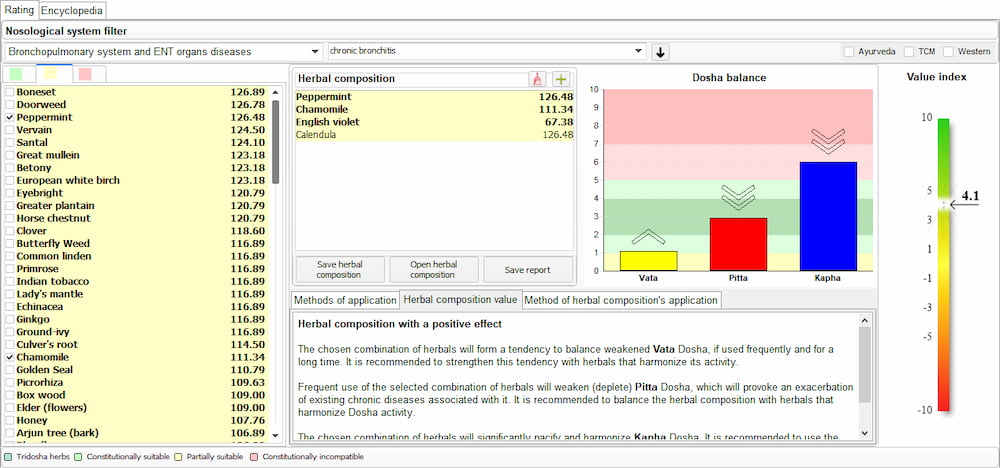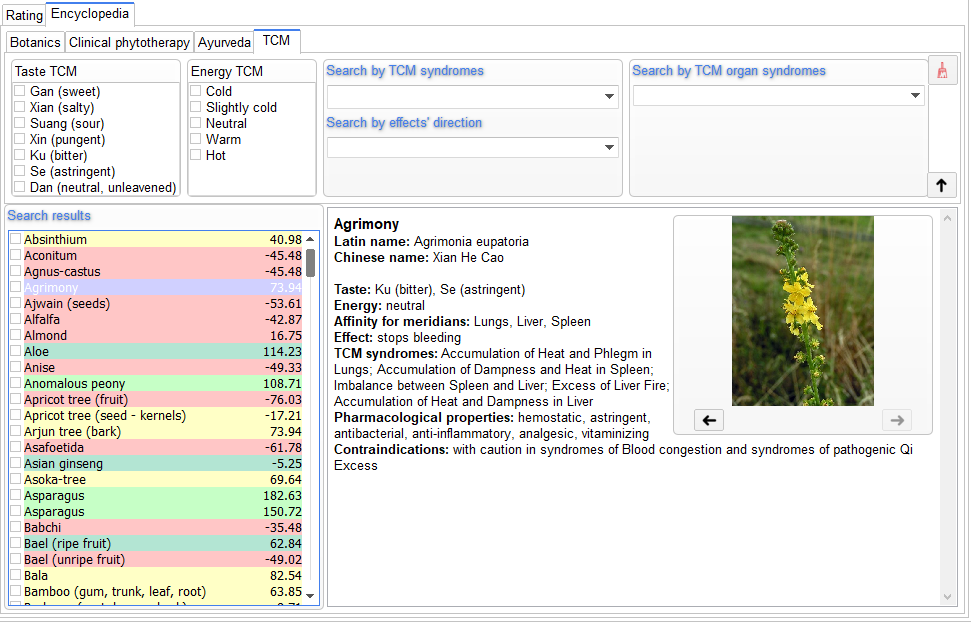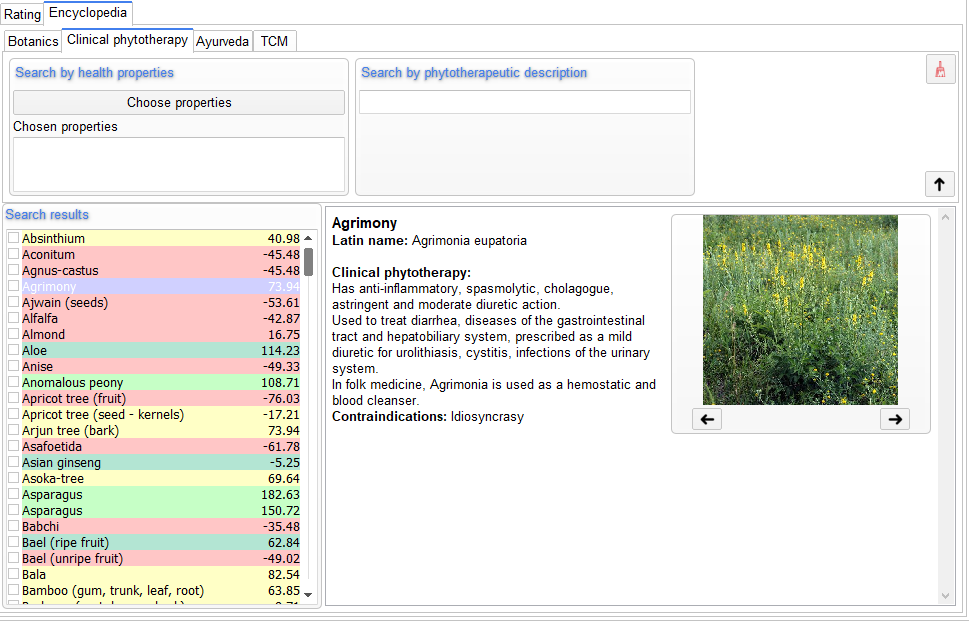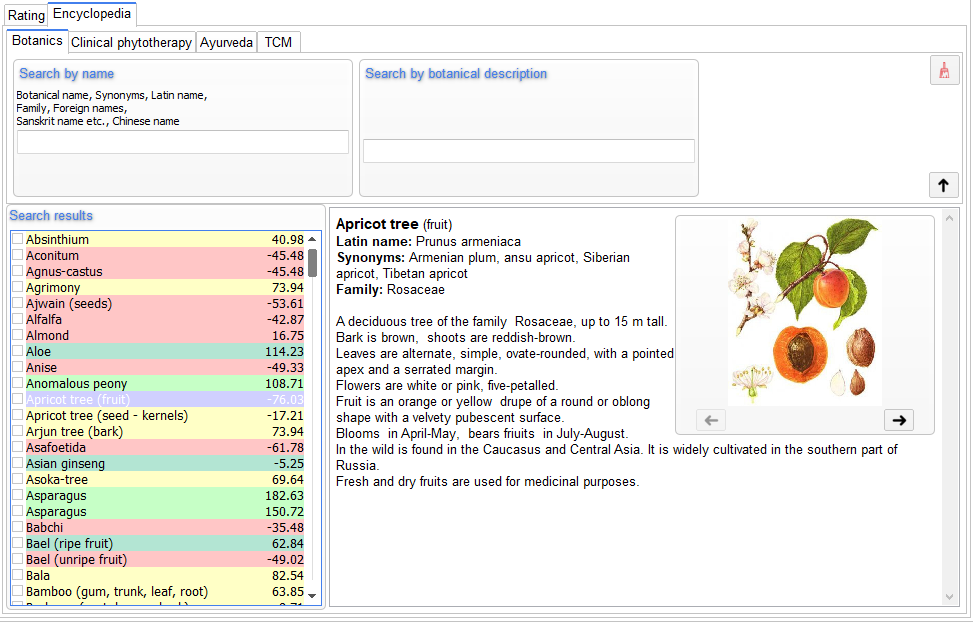Gallery
Herbal Encyclopedia
"Herbal Encyclopedia" is a VedaPulse software module, which allows a specialist to form a personalized herbal composition for the client after a 5-7 minute assessment of the heart rhythm. It is based on mathematical algorithms that take into account the canonical description of herbs from a position of Dravyaguna in Ayurvedic practice, Materia Medica in Chinese herbology and healing properties of herbs from a position of clinical western herbal medicine and naturopathy.
Software module "Herbal Encyclopedia" consists of 3 major sections:
- "Herbal rating"
- "Herbal Encyclopedia"
- "Herbal constructor" (under development)
1. "Herbal rating"

• Allows forming an individual herbal composition based on the assessment of the client's adaptive resource level by means of the instrumental pulse analysis.
• Ranks herbs by the strength of influence on a client.
• Creates a mathematical model of an herb based on the canonical description of its properties (Rasa, Guna, Virya, Vipak, Karma, Dhatu, Dosha, Roga, Meridians, TCM syndromes).
• Assigns the “legend-marker” to herbs, which is affixed individually for each client and encoded in the legend of manual formation of the herbal composition by a specialist.
• Conducts comparative heuristic analysis of herbs with the physiological parameters of the client on the basis of an objective assessment of heart rate to form an individual "herbal traffic light", i.e. three conceptual lists of herbs (red, yellow, green), which are used for the herbal formula composition.
• Additionally filters plants on the nosological principle, allows the specialist to take into account both constitutional and plant properties for pathogenetic therapy of diseases to adjust the herbal composition due to the existing chronic pathology of the client.
• Separates plants to different lists according to the various traditional systems - Ayurveda, TCM, Western herbal medicine.
• Compiles a classic description of the use for different medicinal plants forms (powder, infusion, decoction, etc.), which can be edited by a specialist according to a specific situation.
• Allows creating a set of templates for various diseases to simplify the compilation of the herbal composition.
• Creates a report with a detailed description of the herbal composition and method of application which can be printed or sent by e-mail to the client.
• The main work area of this module section is the so-called "herbal traffic light", which distributes herbs between three tabs.
• Inside the three tabs, herbs are also labeled with the color marker, which reflects one of the four classification properties.
• The possibility to assess the effect of the whole herbal composition on physiological processes and Dosha Balance
• The Dosha Balance graph reflects the forces of influence of the herbal composition on individual doshas, in the form of arrows of efficacy, increase and decrease, where three arrows mean a potent herbal composition, two are moderately acting, one is weak, no arrow means a neutral effect.
• The scale of the herbal composition usefulness index is available, where the total usefulness is presented in the range from -10 to 10.
• The variants of the herbal composition affects are described in text format taking into account the current person's constitution and reflect possible effects on the body. It is necessary to clarify that the individual characteristics of a person, existing diseases, and their sensitivity to the components of medicinal plants should be taken into account.
*A graphic visualization of the effect of a herbal composition on the Dosha balance, index of the usefulness of the herbal composition and text content will be available only in the presence of the Constitution software module.
2. "Herbal Encyclopedia"
Ayurveda part:

• gives an Ayurvedic description of herbs based on the analysis of canonical sources in Dravyaguna (Nighantu) and the expert recommendations of the AYUSH Ministry;
• describes properties of healing herb;
• forms a list of herbs in alphabetical order, with the inheritance of selected herbs in "Herbal rating" section at the top of the list. It helps to speed up analysis of herbs' Ayurvedic properties, while also preserving the legend and the quantitative rating;
• allows to do the search by the filtering the desired herb according to its Ayurvedic properties (Rasa, Guna, Virya, Dhatu);
• The herb is verified by a widespread name, botanical name (Latin), Sanskrit name (and names in other languages accepted in Ayurveda).
"Traditional Chinese Medicine"

• Following canonical authentic texts were used in the development: Yao Хin Lun – Reasoning about the properties of medicines; Ming I Bie Lun – Specific notes of famous physicians; Ben Cao Tu Jing - Illustrated Canon of herbology; Ben Cao Gang Mu – The entire and the details of herbology; Shen-Nong Ben Cao Jing – Canon of herbology by the sacred farmer; Xin Xiu Ben Cao – Newly compiled book on herbology; and others.
• Describes the properties of the medicinal plant.
• Generates a list of herbs in alphabetical order with the inheritance of the selected plants in the "Herbal rating" at the top of the list, to accelerate their analysis of TCM properties, while also maintaining the legend and quantitative rating.
• It allows searching for the desired herb with the filtration by the main TCM syndromes.
• Search the desired herb by filtering its type of action from the position of TCM.
• It allows searching for the desired herb by applying the filter for one of more than 150 organ syndromes in TCM.
• Herbs are verified by the common name, botanical (Latin) name, Chinese name.
"Clinical Phytotherapy"
• Forms a detailed description of the medicinal properties of the herb based on the analysis of the latest scientific data in the field of phytopharmacology;
• Focuses the attention of a specialist on diseases, in which the effect of this herb is proven;
• Describes the pharmacological ingredients contained in the herb;
• Allows searching for the necessary medicinal properties according to phytotherapeutic description of the herb;
• Keeps the herbs, selected in the “Herbal rating” in alphabetical order, for a quick analysis of their medicinal properties from the clinical phytotherapy point of view;
• Describes detailed contraindications for the herb;
• Saves both legend and quantitative rating of herbs in the alphabetical order;
• Allows multiple selection of herbs according to more than 90 pharmacological properties.
"Botanics"

• Generates a detailed botanical description of the herb. Botanical description includes Latin name and family, description of the parts of the herb, time of ripening/flowering and harvesting, vegetation areas, part of the herb to be used;
• Generates a list of herbs in alphabetical order with the inheritance of the selected herbs in the "Herbal rating" at the top of the list to speed up the analysis of their botanical properties, while also maintaining the legend and quantitative rating;
• Allows for a quick search of an herb by botanical name, synonymous name
Target audience
Herbal Encyclopedia is primarily designed for herbal therapists allowing them to obtain objective information about health status of the client and give best recommendations for medicinal plants based on the client’s current constitution. Besides, Herbal therapy can be beneficial to:
- For Welness Center Manager
- For Acupuncture specialist (TCM specialist)
- For Ayurveda specialist
Principles of the Herbal therapy module were also used in another VedaPulse expert extension, which helps to individually select Food Supplements. Any Food supplement is composed of natural ingredients, which are presenting a well-balanced herbal composition. This principle allowed creating an instrument for selecting constitutionally balanced Food Supplements.
| Attachment | Size |
|---|---|
| Herbal_Encyclopedia_Example.pdf | 1.46 MB |
- Login to post comments
User login
Last articles










